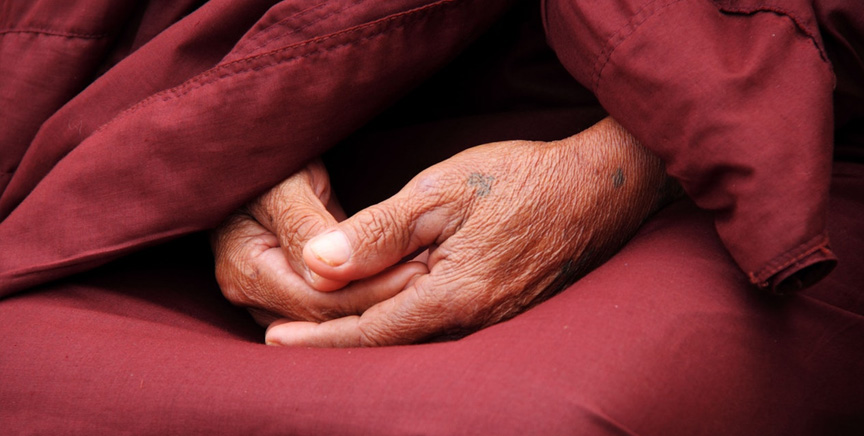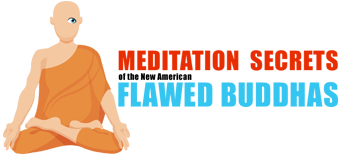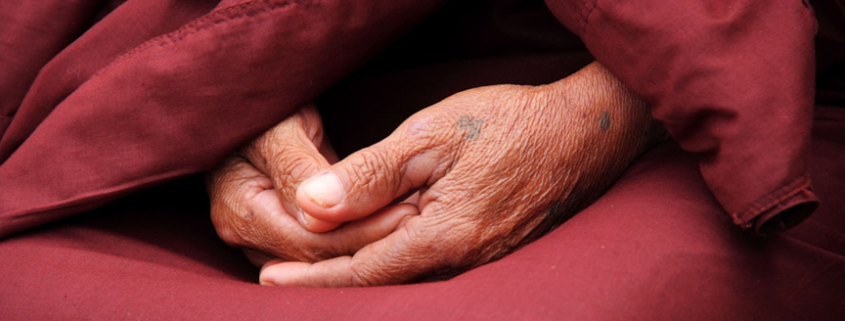Last Updated on March 19, 2021 by Paul Farrell, MRP, JD, PhD

Five trends: History of America’s bizarre myth that “sitting like a zen monk” is the “only” way to meditate!
“According to an old Taoist saying,
‘meditation in action is a hundred times, no, a thousand times, no, a million times greater than meditation in stillness’ …
There are indeed many activities that easily lend themselves to meditation in action: walking, dressing, bathing, doing any repetitive task … And finally, every aspect of living might well benefit from the simplest and most profound practices known on this planet.”
– George Leonard, The Way of Aikido
Mention the word “meditation” and most people immediately think of sitting meditation. You’ll even get a mental image of Tibetan monks sitting silently in the lotus position.
The media reinforces this popular image with articles and books that give us the impression that sitting meditation really is the only way to meditate. This emphasis on sitting meditation is understandable, having evolved slowly over the past forty years. Five trends created and reinforce this belief:
Trend # One: Medical Profession 1975!
Harvard Doctor Rebrands Ancient Zen Meditation as Passive “Relaxation,” the New Modern Treatment for Stress-Related Diseases and Pathologies.
Cardiologist Herbert Benson’s 1975 bestseller The Relaxation Response described how mental stresses create physical diseases. Stress was inherently damaging, the solution was stress reduction. Based on his studies of Tibetan monks and Transcendental Meditation practitioners, Benson put into simple layman’s language the steps for effective sitting meditation. Actually, Benson was merely redefining what the old masters have been doing for centuries.
Unfortunately, the sixties hippies were also ‘into’ Eastern mystics, making the public leery of their meditation. As a result, Benson’s relaxation response proved to be a brilliant stroke of marketing genius, giving “meditation” a new legitimacy separate from the hippie drug culture, while paving the way for a wave of new stress reduction clinics that emphasized sitting meditation.
Trend # Two : Hollywood Fame!
The Dalai Lama Awarded 1989 Nobel Peace Prize, Scorsese and Brad Pitt Carry Him Into the Hearts of the World.
The Dalai Lama was awarded the Nobel Peace Prize in 1989. Since then Tibetan Buddhism has fascinated the American public, while taking over the media spotlight on a regular basis. In 1997 Hollywood released two films about the Dalai Lama: Scorsese’s Kundun and Brad Pitt’s Seven Years in Tibet.
Thanks to the public charisma and quiet charm of this humble man, the number of Buddhist meditation centers has increased dramatically in America. And as we search for new ways to cope with the increasing level of stress in Western culture, the Noble Peace Prize has triggered a steady stream of articles and books on Tibetan culture, the Buddhists’ peaceful way of life and Eastern methods of sitting meditation.
Trend # Three : New MRI Technologies!
How Bulky Machines Restrict Scientific Research to Stationary Subjects Like the Wired-Up Heads of Sitting Monks.
In the eighties, magnetic resonance imaging (MRI) became the primary diagnostic tool for neuroscientists, stress reduction clinicians, psychologists, physicians, and other mind/body researchers studying the meditating brain. The powerful MRI scanning technology helps professionals “see” and analyze human emotions and decision-making using colorful pictures of the brain, which also make great illustrations in media coverage on meditation.
Unfortunately, MRI machines have some major limitations: They’re bulky and immobile, weighing tons and costing millions. As a result, neuroscientists and stress management experts limit themselves to testing stationary subjects, such as Tibetan monks, rather than athletes and other moving subjects.
Trend # Four : Today’s Press & Social Media!
An Endless Overwhelming Barrage of Photos, Articles, Channels, Blogs and Promotions, as Modern Sitting Meditation Gurus Takeover and Dominate the Media Spotlight!!
These four trends came together recently when the Dalai Lama and Tibetan Buddhist scholars from around the world participated with Western neuroscientists and stress management professionals in a widely-publicized “Investigating the Mind” conference at Massachusetts Institute of Technology.
Science magazine called the conference a significant merger of Eastern and Western cultures: “Buddhists, with their 2500-year history of introspective inquiry into the nature of the mind, have much to offer neuroscientists.” However, one skeptical neuroscientist expressed concern about the obsession to “get the electrodes on the monks.” In spite of that, the conference was successful and sitting meditation is still center stage.
These four trends also tell us why our meditation bookshelves are stocked almost exclusively with books on sitting meditation; and why articles on meditation in the popular press are invariably illustrated with MRI brain scans and photos of monks sitting passively in the lotus position.
Trend # Five : The New Sports-Fitness Revolution!
How Sports Psychologists Rediscovered how Remarkably Essential Stress is to the Development and Growth of the Human Body, Mind and Spirit as a Positive, Healthy, Powerful Energy!
While all these neuroscientists, doctors and stress management clinicians have been limiting the definition of meditation to just sitting, a new movement was quietly moving in the opposite direction and expanding the definition of meditation. Most of these people discovered through trial and error that sitting meditations doesn’t work well for them, so they’ve been searching for alternative ways to manage stress and enhance their lives.
This shift is most obvious in comparing Dr. Herbert Benson’s Relaxation Response with the work of sports psychologists such as Dr. James Loehr and his Challenge Response. They approach stress from extreme opposite directions.
Dr. Benson and the medical profession come from a belief system that focuses on disease and pathologies: Historically, in the so-called “Medical Model” stress is bad. It damages the body. In contrast, sports psychologists see stress as challenging, yet positive and healthy. When Loehr says “everything you know about stress is wrong” he is challenging the underlying belief system of the medical profession.
For the past couple decades, sports psychologists have been proving that stress is healthy, that stress is positive and natural for humans, and that stress is not only manageable, it helps us tap into a powerful inner resource that is constantly challenging us to reach for our highest potentials, as athletes and as humans. In this new paradigm, stress is neither bad nor to be avoided, it is seen as a positive challenge and a powerful source of energy.
About the Author
Dr. Farrell is a Behavioral Economist. His books include The Millionaire Code; The Millionaire Meditation: Stress Management for Wall Street, Corporate America & Entrepreneurs; The Zen Millionaire; The Winning Portfolio; Expert Investing on The Net; Mutual Funds on The Net; and The Lazy Person’s Guide to Investing.
He also published 1,643 columns on DowJones-MarketWatch and for years was their #1 traffic-generating columnist. Before the Internet, he edited & published FNX: Future News Index, a financial newsletter for stock market traders. Earlier he was a Wall Street investment banker with Morgan Stanley, Executive Vice President of the Financial News Network; and Associate Editor of the Los Angeles Herald Examiner.
He has a Doctorate in Psychology, Juris Doctor, Masters in Regional Planning and Bachelor of Architecture. He worked on the Esalen organic farm and served in the U.S. Marine Corps as Staff Sergeant in aviation computer technology.








